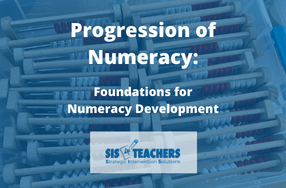
The two previous blogs in the Importance of Numeracy Screening series looked at the idea of real objects in the physical world and looking at the development of kinesthetic one-to-one correspondence. This is followed by spending some good quality time on conservation to a number with mixed modalities, taking it from a five-frame (horizontally, vertically, then a scatter) all the way up through a double ten-frame using the Counting Buddy Senior and a rekenrek to look at 20 in different ways.
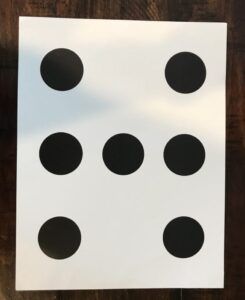 After kids have lots of experience with conservation to a number, the next idea we assess kids for is the concept of part-part-whole. This involves decomposing, or breaking a number part into more than one part. If I show students in kindergarten or 1st grade a scatter with three on the top, one in the middle and three on the bottom, and listen to their responses as they tell me how they know how many there are, I will get a variety of responses that show that kids are starting to decompose automatically. Some kids might say, “I saw six and then one more,” some might say “I saw five like a dice in the center and then two more.” They might even say they saw four (one in each corner like a dice) and three in the middle to make seven. Kids that are more advanced might even say, “It’s two less than nine – I know three and three and three is nine and there are two missing.”
After kids have lots of experience with conservation to a number, the next idea we assess kids for is the concept of part-part-whole. This involves decomposing, or breaking a number part into more than one part. If I show students in kindergarten or 1st grade a scatter with three on the top, one in the middle and three on the bottom, and listen to their responses as they tell me how they know how many there are, I will get a variety of responses that show that kids are starting to decompose automatically. Some kids might say, “I saw six and then one more,” some might say “I saw five like a dice in the center and then two more.” They might even say they saw four (one in each corner like a dice) and three in the middle to make seven. Kids that are more advanced might even say, “It’s two less than nine – I know three and three and three is nine and there are two missing.”
When kids are able to think on this higher level, especially when looking at a scatter of 0-10, we know that kids are starting to understand how numbers can be broken into two parts. We then want to see if kids can look at a number and break it into two parts. For example, if I show a number, do kids know all the parts it can be broken into? For you and I, it seems easy to start listing what we know to be the parts of the number eight – seven and one, six and two, five and three, four and four. It goes the other way too – we want to see if kids are able to look at two quantities, like five and three (maybe in a domino pattern) and quickly be able to say that the total is eight. By the end of 1st grade, we want kids to be able to see part-part-whole up to ten.
Understanding Combinations and Missing Parts
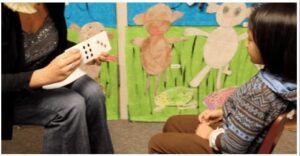 Our assessment, Understanding Combinations and Missing Parts, focuses on this area of numeracy development to see if are they ready to see part-part-whole. In this assessment, we use red and blue dots, as we do in our other assessment, but these cards feature the actual digit on one side. While administering the assessment, we hold the card with the digit covered, and flash the dots towards the child long enough for them to look at it, but not long enough for them to count one-to-one. We want to see if the child can look at those two configurations and put them together quickly. If they were to see a five and a four (both configured like a dice), could they quickly say nine? And what can they tell you about how they know how many? Maybe something like, “The reason I know it’s nine is there’s one in the middle that’s missing.” In this assessment, we work through a list of combinations to see how many of these they know fairly readily and how many are more difficult for kids to see.
Our assessment, Understanding Combinations and Missing Parts, focuses on this area of numeracy development to see if are they ready to see part-part-whole. In this assessment, we use red and blue dots, as we do in our other assessment, but these cards feature the actual digit on one side. While administering the assessment, we hold the card with the digit covered, and flash the dots towards the child long enough for them to look at it, but not long enough for them to count one-to-one. We want to see if the child can look at those two configurations and put them together quickly. If they were to see a five and a four (both configured like a dice), could they quickly say nine? And what can they tell you about how they know how many? Maybe something like, “The reason I know it’s nine is there’s one in the middle that’s missing.” In this assessment, we work through a list of combinations to see how many of these they know fairly readily and how many are more difficult for kids to see.
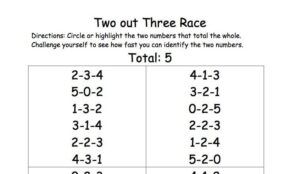
Another way of assessing this as we look at the pictorial part is to use one of our downloads, Two Out of Three Race. In this download, you have a focus number at the top of the page, and sets of three numbers listed on the rest of the page. The goal is to see how quickly the kids can find two of the three numbers that equal the total (focus number). As they do this, we can see if kids can compose numbers to tell the total.
Missing Addends
We want to make sure kids pass the combination part of the assessment with a high percentage, meaning they know a lot of the combination cards pretty quickly and can tell you why they know. When they, we can move students into missing addends or parts. If the total number on the card is eight, two in the center with six next to it, I might cover up the six dots, hold it up and say, “I wish that I had eight, but I only see two.” Are the kids able to tell you the missing part? Are they able to visualize the total quantity and what is needed to make it complete based on the part they know? You can cover the first or second number in the dots.
Often, kids will do well with doubles. If you say, “I wish I had eight but I only have four,” they know pretty quickly that they need four more. But how do they do when you are trying to make eight and you show them three? Do they know the other part is five?
When we’re looking at this, we don’t necessarily want to have them work with part-part-whole yet in an algorithm format. We want kids can play with and understand combinations and missing parts at a level that makes sense to them.
Building Part-Part-Whole Understanding
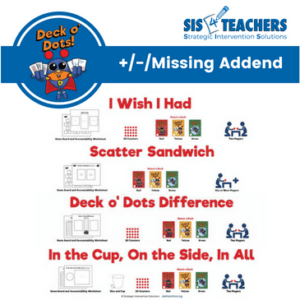 Deck o’ Dots games are great for kids that are at this level, especially in our +/-/Missing Addends Bundle. This bundle will focus on games like I Wish I Had and Scatter Sandwich, or even Deck o’ Dot Duel with a double flip so kids can see the parts of the numbers (depending on which deck you’re using). This came comes with a really great accountability sheet that uses number bonds to help kids see the number that’s shown, how many they see on their cards, and what the other part is.
Deck o’ Dots games are great for kids that are at this level, especially in our +/-/Missing Addends Bundle. This bundle will focus on games like I Wish I Had and Scatter Sandwich, or even Deck o’ Dot Duel with a double flip so kids can see the parts of the numbers (depending on which deck you’re using). This came comes with a really great accountability sheet that uses number bonds to help kids see the number that’s shown, how many they see on their cards, and what the other part is.
Developmentally, we want kids to stay in this concept of part-part-whole as long as they need to help them really understand it. Deck o’ Dots games are a great way to do that, offering a variety of ways to differentiate play, but here are some other ideas for keeping kids engaged as they work through this difficult stage of numeracy development.

There are some other great apps that can help kids decompose: Number Bond Blaster ($1.99 – iTunes) and MathTappers:Find Sums (free – iTunes).
 We want to move kids more into a number bond format when they’ve demonstrated a good understanding of part-part-whole. For example, I give a total of nine, students are given a part like five (in a digit format), and students have to complete the number bond to find the other part. You could also show kids the two parts, like six and three, could they determine what the total is. Our Number Bond Addition/Subtraction cards are really good for this concept because kids can have a deep look at what that part/part/total is. You can also find a lot of pages that have different kinds of sprints that kids can do using the number bonds. Download a free Number Bond Race from our store!
We want to move kids more into a number bond format when they’ve demonstrated a good understanding of part-part-whole. For example, I give a total of nine, students are given a part like five (in a digit format), and students have to complete the number bond to find the other part. You could also show kids the two parts, like six and three, could they determine what the total is. Our Number Bond Addition/Subtraction cards are really good for this concept because kids can have a deep look at what that part/part/total is. You can also find a lot of pages that have different kinds of sprints that kids can do using the number bonds. Download a free Number Bond Race from our store!

The Counting Buddy offers a variety of games to play with students as well to help solidify the part-part-whole idea. Show the kids an amount on the beads and play the “I Wish I Had” game. Pull down six beads and then say, “I wish I had nine. How many more do I need?” The more kids can see that whole and then the part and find out the other part, or see the parts and find out the total, the better kids will be equipped for division and subtraction skills. A grasp of the part-part-whole concept is a precursor skill for kids to be able to add larger addition problems with two digit and one digit or two digit and two digit, or perhaps even higher.
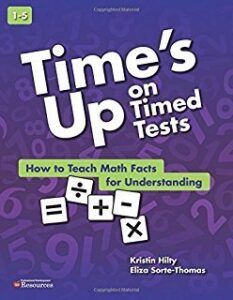 The next step isn’t timed fact tests. We want to focus on kids breaking apart or decomposing numbers. After you feel confident that kids understand this concept of missing parts and combinations, you can then reference our Time’s Up on Timed Tests. Eventually, students are going to decompose and make ten or make 20 or go to a friendly benchmark/landmark or just a friendly number like decades. There are also games you can play with the rekenrek, where you can hide part of it and have kids determine which part is hidden. We have a great download, Abacus Fun Activity Pack, that has a section on combinations and missing parts that kids could use with the rekenrek.
The next step isn’t timed fact tests. We want to focus on kids breaking apart or decomposing numbers. After you feel confident that kids understand this concept of missing parts and combinations, you can then reference our Time’s Up on Timed Tests. Eventually, students are going to decompose and make ten or make 20 or go to a friendly benchmark/landmark or just a friendly number like decades. There are also games you can play with the rekenrek, where you can hide part of it and have kids determine which part is hidden. We have a great download, Abacus Fun Activity Pack, that has a section on combinations and missing parts that kids could use with the rekenrek.
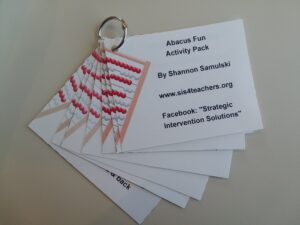
Numeracy Screener Flowchart
Based on all three of our blogs in this series, use this handy flowchart to see where we want kids to be in the development of the various stages of numeracy. Download the free PDF from our store!



